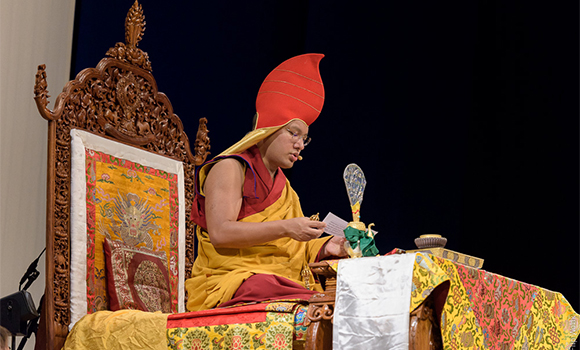
Bonn, Germany – 30th August, 2015
10.00am
The stage of the auditorium had been specially prepared for this morning’s empowerment. On the right-hand side of the stage stood a screened area containing a small altar with offerings placed in front of a thangka of Akshobhya Buddha. In this private space, the Karmapa would perform the preliminary and closing rituals of the empowerment. During the preliminaries, the chant masters led the audience in a deeply felt recitation of the mantra ‘Karmapa Khyenno’, and the steady cadence of the chanting was punctuated at intervals by the ringing of His Holiness’ ritual hand bell from behind the screen. Once the preparations were complete, His Holiness left the stage, to return a few minutes later in procession. Prostrating three times, the Karmapa then took his seat on the throne and the chant masters began the Kagyu Lineage prayer, followed by a mandala offering requesting the teachings. The body, speech and mind offering was led by Ringu Tulku Rinpoche, followed by lamas from Kagyu centres in Germany.
Before commencing the central part of the empowerment, His Holiness took time to explain the importance of the Akshobhya practice which is praised as the supreme method for purifying karmic obscurations, the obscurations created by our actions. He described how, because of technological development and the like, the actions of humans in the 21st century exert a much greater impact than ever before. Human activity has had a disastrous effect on the world; it has done great harm to both the ‘container’ which is the outer environment and to the ‘content’, other sentient beings.
“Millions and billions of sentient beings are killed on a monthly basis,” His Holiness commented, “for the purpose of obtaining food… and many sentient beings are subjected to harsh treatment in order for human beings to have food and clothing.”
“I think we have reached a time when human beings have perfected the capacity to destroy the world,” he warned. “For that reason we need to think very clearly about the types of action we want to engage in and develop a sense of responsibility for our choice of action.” He continued: “Now human beings have become a very dangerous species. We usually consider tigers and lions as fierce and terrifying, but if we think about the health of the world and the precarious future of the planet, we will realise that in fact human beings are the most dangerous sentient beings.”
The main cause of negative actions is negative motivation, untamed states of mind which are not peaceful. “When our mind is governed by these types of motivation,” the Karmapa explained, “our outer conduct becomes harmful and coarse.” This effect is very evident nowadays. “The world has been afflicted by violent conflicts and incidents,” he elaborated, “and due to this I think it’s very common that many of us have a feeling of insecurity that is pervasively present in our minds.” He described this as “a continuous feeling of unease and lack of well-being”, and gave travel as an example. It now generated much more anxiety than previously, and in Europe, which was once considered a bastion of peace and stability, violent conflict has become more evident. The root cause is the motivation of human beings whose minds are disturbed by anger and hatred, hence violence occurs.
The purpose of the Akshobhya practice is to offer us a method which prevents our mind being overwhelmed by negative emotions, especially anger and hatred. The empowerment itself, the Karmapa explained, could be understood as making an auspicious connection with Akshobhya and permission to do the practice, or it could be taken as a blessing. “It is only the beginning,” he emphasised. “Now you have to do the practice.” The main point is for all of us to put effort into protecting our own mind streams from aggression and anger.
His Holiness then completed the empowerment, and, after a mandala offering and the concluding rituals returned to stand on the stage to make some final observations. As he began speaking, he spotted a little girl running towards the front of the auditorium. Smiling, he moved forward to the edge of the stage, leaned over and graciously accepted a picture she had drawn for him–two red hearts and a sky full of rainbows. Holding it up, he showed it to the enchanted audience, then resumed thanking everybody for coming and expressed his hope that after his second visit to Germany he would soon be able to visit dharma friends in other countries too.
Finally, the Karmapa detailed the status of the search for the reincarnations of Tenga Rinpoche and Akong Rinpoche, two lamas who had strong connections with many European students. Concerning Tenga Rinpoche, His Holiness said, “I have a great hope and prayer that we will soon meet with the reincarnation of Rinpoche.” “With regards to Akong Rinpoche,” he said, “it may be difficult to find the reincarnation immediately, but, nevertheless, I have had a connection with Akong Rinpoche since I was very young and we have been close, so I will definitely continue reflecting on this topic.” He advised disciples of both lamas to “let your minds be at ease. Continue sustaining the activities and teachings of your teachers, and that will suffice.”
Lunchtime had arrived. His Holiness left the stage to loud applause, with the promise that he would return in the afternoon to deliver his final public talk.


